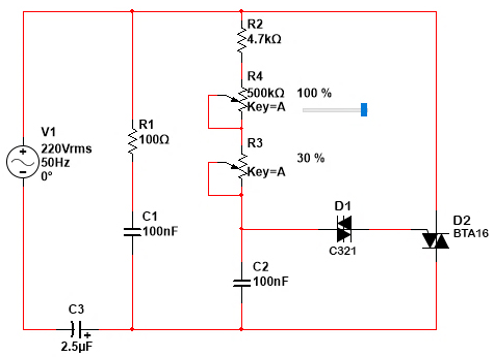Power Factor Improvement Using Capacitor Controlled Based on Dimmers

Downloads
The utilization of electric power predominantly involves inductive loads, which result in lagging voltage waves that increase power consumption beyond what is effectively utilized, thereby reducing power factors and causing energy losses. To mitigate reactive power from inductive loads, capacitors are commonly installed in parallel. However, conventional fixed capacitor banks often lead to suboptimal results due to improper sizing. This study presents an innovative power factor correction device utilizing dimmer-controlled capacitors for dynamic capacitance adjustment. The research offers a cost-effective alternative to microcontroller-based systems while providing real-time adaptability for varying loads. The system enables precise control of capacitance without complex programming. The experimental approach uses six parallel-connected capacitors (2.5μF each), controlled by a dimmer circuit with TRIAC, DIAC, and potentiometer components. Testing is conducted with variable inductive loads ranging from 1.7 H to 6.8 H, simulating laboratory conditions with potential for scaling to real-world applications. The methodology includes baseline measurements, capacitor compensation, load variation analysis, and performance evaluation. Results demonstrate power factor improvement from 0.55 to 0.85 using a capacitance range of 0.6299μF to 15μF. The dimmer-controlled approach effectively increases active power while reducing reactive power from 56.198 VAR to 33.773 VAR, significantly improving voltage stability under varying load conditions.
Downloads
[1] A. Dani, "Power Factor Improvement Using Capacitors as Reactive Power Compensators (Case Study of STT Sinar Husni)," in Royal National Seminar (SENAR), 2018, pp. 673–678.
[2] M. A. Rezaei, M. Nayeripour, J. Hu, S. S. Band, A. Mosavi and M. -H. Khooban, "A New Hybrid Cascaded Switched-Capacitor Reduced Switch Multilevel Inverter for Renewable Sources and Domestic Loads," in IEEE Access, vol. 10, pp. 14157-14183, 2022, doi: 10.1109/ACCESS.2022.3146256.
[3] S. Graha, "Power Factor Improvement Design," INTEKNA Journal, 2014.
[4] M. N. Zaidi and A. Ali, "Power factor improvement using automatic power factor com-pensation (APFC) device for medical industries in Malaysia," in MATEC Web of Confer-ences, vol. 150, 2018.
[5] E. H. Sadiq and R. K. Antar, "The Impact of Optimal Sizing and Placement of Capacitor Banks in Distribution Networks: Enhancing Voltage Profiles and Reducing Power Loss-es," J. Intell Syst. Control, vol. 4, no. 1, pp. 1-9, 2025. https://doi.org/10.56578/jisc040101.
[6] H. J. Jabir, J. Teh, D. Ishak, and H. Abunima, "Impacts of demand-side management on electrical power systems: A review," Energies, vol. 11, no. 5, p. 1050, 2018.
[7] A. Khan, “Hardware-in-the-loop implementation and performance evaluation of three-phase hybrid shunt active power filter for power quality improvement,” Mathematical Problems in Engineering, vol. 2021, pp. 1–23, 2021.
[8] A. T. N. Angga, M. S. Messiah, D. Rinaldi, M. F. Ramadhan, and M. J. Shiddiq, "Solutions for Growing the Power Factor Prevent A Reactive Electricity Tariff And Decrease Warmth On Installation With Bank Capacitors," Applied Technology and Computing Science Journal, vol. 4, no. 1, pp. 35–46, 2021.
[9] Stevenson, Power System Analysis. Singapore: McGraw-Hill, 1994.
[10] A. Khoirudin and S. T. Umar, "Rancangan Alat Perbaikan Faktor Daya Portabel untuk Rumah Industri," M.S. thesis, Universitas Muhammadiyah Surakarta, 2022.
[11] R. R. Reza, "Rancang Bangun Perbaikan Faktor Daya Menggunakan Kapasitor Bank Berbasis Mikrokontroler Untuk Beban Rumah Tangga Dengan Daya Maksimal 900 W," M.S. thesis, Politeknik Manufaktur Negeri Bangka Belitung, 2021.
[12] D. P. Alfauzi, A. G. Permana, and A. Novianti, "Rancang Bangun Alat Perbaikan Faktor Daya Listrik Satu Fasa Berbasis Mikrokontroler," EProceedings of Applied Science, vol. 5, no. 3, 2019.
[13] A. Prasetia, L. Sartika, and R. Alfian, "Implementation of Fuzzy Logic Control on Auto-matic Voltage Regulator for 3 Phase Synchronous Generator," in Proceedings of the In-ternational Conference on Sustainable Engineering, Infrastructure and Development (ICO-SEID 2022), Jakarta, Indonesia, Dec. 2023, pp. 23–24.
[14] A. M. Prasetia, L. Sartika, and S. Riyanto, "Design and Develop an Automatic System for Monitoring Electrical Quality and Controlling Power Factor in Household Electrical Loads Using Capacitors," Fidelity: Jurnal Teknik Elektro, vol. 5, no. 3, pp. 206–215, 2023.
[15] F. Hunaini, A. R. Adisyahrudin, and S. Setiawidayat, "Perbaikan Faktor Daya Pada Beban Listrik Skala Rumah Tangga Dengan Metode Fuzzy Logic," JASEE Journal of Application and Science on Electrical Engineering, vol. 4, no. 2, pp. 11–21, 2023.
[16] R. Risdina, "Rancang Bangun Sistem Monitoring Dan Perbaikan Faktor Daya Pada Kon-sumsi Listrik Rumah Tangga Berbasis Mikrokontroler Atmega32," M.S. thesis, Universitas Islam Negeri Sumatera Utara, 2019.
[17] C. Sarri, "Analisis Perbaikan Faktor Daya Untuk Efisiensi Pembebanan Pada RSUD IA Moeis Samarinda," Mutiara: Jurnal Ilmiah Multidisiplin Indonesia, vol. 1, no. 1, pp. 126–139, 2023.
[18] Y. Adhimanata, "Capacitor Bank Panel Design to Improve Industrial Power System Effi-ciency and Safety," Procedia of Engineering and Life Science, vol. 7, pp. 233–239, 2024.
[19] S. Mane, R. Sapat, P. Kor, J. Shelar, R. D. Kulkarni, and J. Mundkar, "Microcontroller based automatic power factor correction system for power quality improvement," in Proc. 2020 Int. Conf. Emerging Technol. (INCET), Belgaum, India, 2020, pp. 1–6, doi: 10.1109/INCET49848.2020.9154008.
[20] A. A. Imam, R. Sreerama Kumar, and Y. A. Al-Turki, "Modeling and simulation of a PI controlled shunt active power filter for power quality enhancement based on P-Q theory," Electronics, vol. 9, no. 4, p. 637, 2020, doi: 10.3390/electronics9040637.
[21] F. C. Kurniawan, Perbaikan Faktor Daya Listrik Secara Otomatis Menggunakan Mikro-kontroler Arduino Mega 2560 Dengan Tampilan HMI SCADA, Tugas Akhir, Universitas Diponegoro, 2022.
[22] R. Utomo, A. Wirawan, W. Margono, and N. Alham, “Design of Automatic Power Factor Correction for Optimization of Electric Energy Consumption”, JurnalEcotipe, vol. 11, no. 1, pp. 10-18, Apr. 2024.
Copyright (c) 2025 Jurnal Edukasi Elektro

This work is licensed under a Creative Commons Attribution-ShareAlike 4.0 International License.
The Authors submitting a manuscript do so on the understanding that if accepted for publication, copyright publishing of the article shall be assigned to Journal.



















